
|
Warning!
At least some content in this article is derived from information featured in: Hogwarts Legacy & Harry Potter: Puzzles & Spells & Harry Potter: Magic Awakened & Harry Potter: Wizards Unite & Harry Potter: Hogwarts Mystery. |
- "Wizards represent all that the true 'Muggle' most fears: They are plainly outcasts and comfortable with being so. Nothing is more unnerving to the truly conventional than the unashamed misfit!"
- — J. K. Rowling's overview of Wizardkind
Wizardkind[5][6][7][8] were humans that were born with the ability to perform magic. An individual male human with magical ability was known as a wizard (plural: wizards), and an individual female human with magical ability was known as a witch (plural: witches), though "wizard" was sometimes used as a gender-neutral singular noun like "man". There were three statues of wizardkind, Pure-blood, Half-Blood and Muggle-borns, and they were relative to Squibs and Muggles.
It was said that most of the greatest wizards did not have an ounce of logic, suggesting their complete reliance of powerful magic led them to neglect other aspects of their mind.[9]
Origins
The origins of wizardkind was unknown. Whether, in ancient times, some humans randomly discovered they had magic, or there was some sort of ritual or potion or pact, their origins remain a mystery. However, if it was the first, then some Muggle-borns may not be the descendants of Squibs (as is most often theorised) but entirely new wizards, like the very first members of wizardkind.
Performing magic
In childhood, wizards and witches may have exhibited random bursts of magic, called accidental magic, which were honed and controlled as they progress to maturity.[10][11]
To perform controlled magic, almost all wizards/witches needed to use a wand, although the advanced skill of wandless magic may have been mastered in later life. A few highly advanced wizards could do controlled magical feats without a wand, such as Albus Dumbledore, who demonstrated the ability at the close of Harry Potter's first year at Hogwarts School of Witchcraft and Wizardry,[10] and Lord Voldemort, who once demonstrated this ability during the Battle of the Seven Potters in 1997.[12]
Heredity
- "Most wizards these days are half-blood anyway. If we hadn’t married Muggles we’d’ve died out."
- — Ron Weasley discussing blood purity[src]
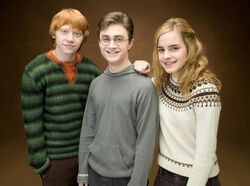
The trio (left to right): Ron Weasley: pure-blood; Harry Potter: half-blood; Hermione Granger: Muggle-born
Magical ability was an inherited trait usually passed from parent to child. Wizards and witches are classified by blood status.[13]
Pure-bloods were born of two wizarding parents and at the very least, four wizarding grandparents. However, many believed a pure-blood family tree should have no Muggle ancestors despite the fact that every family tree had at least one Muggle ancestor by the 1990s.[14]
Half-bloods were mainly born of one wizard and one Muggle or Muggle-born parent.[13]
Muggle-born wizards and witches were distantly descended from a Squib who had married into a Muggle family. The magical gene resurfaced many years later in a Muggle-born descendant when that branch of the wizarding family had usually lost all traces of its wizarding legacy.[13]
Physiology
The physiology of wizards was subtly different from that of non-wizards. As such, wizards would react differently to the effects of contact with a magical creature, such as being attacked by a murtlap.[15] Wizards also by nature could not be fooled by certain types of magic or magical barriers. It was, for example, possible to hide certain magic from Muggles via Muggle-Repelling Charms, which naturally would have no effect on wizards.[16]
Wizards had the power to cure 'mundane' illnesses and injuries, and contact with non-magical creatures that Muggles could not. However, they could struggle to repair any damage caused by magical means such as the Memory Charm and Unforgivable Curses.[17]
Despite their science and living conditions being almost Medieval, wizards were, ironically, probably healthier than Muggles, presumably due to their inherent magic protecting them from most mundane illnesses.[17]
Life span
- See also: List of oldest wizards
Wizard life expectancy in Britain reached an average 137¾ years in the mid-1990s, according to the Ministry of Divine Health,[18] although the oldest wizard on record reached the age of 755 in late 1991;[19] wizards in general have a much longer life expectancy than Muggles,[20] usually living two or three times as long as their non magical counterparts, some living even longer than that depending on circumstances.
Physical appearance
Most wizards looked no different from Muggles, although some wizards bear unusual physical characteristics. Rolanda Hooch, for instance, had yellow eyes.[10] This was consistent with some magic being shown to affect bodily appearance, especially the eyes (as, for instance, Tom Riddle's eyes turned bright red after his constant use of the Dark Arts).[21] In other cases, this may simply have been a cosmetic application of self-transfiguration or charm work to alter the colour of one's eyes or hair to reflect the wizard's personal preferences.
Sub-types
- "I am a wizard, not a baboon brandishing a stick."
- — Filius Flitwick setting Seamus Finnigan lines[src]
Some wizards exhibited special inborn (or acquired) attributes which marked them as unique amongst their kind. They are listed as follows:
Inborn Attributes
These often hereditary traits marked subdivisions within wizardkind.
Seers
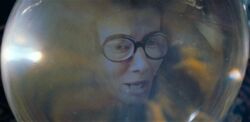
Sybill Trelawney was a Seer and Professor of Divination at Hogwarts
Some wizards were born with abilities beyond those of the average wizard. Seers, for example, had the skill of insight into future events. They may have garnered this insight through visions and dreams or through scrying physical objects like tea leaves, tarot cards, and crystal balls. Some seers included Sybill Trelawney and her ancestor Cassandra.[11][22]
Metamorphmagi
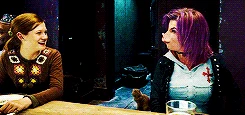
Nymphadora Tonks changing her appearance at will
Other wizards may have had the ability to change only their physical appearance rather than their bodily form. This type of wizard was termed a Metamorphmagus. Such a wizard could change the shape of their noses, hair colour, and other physical attributes. Nymphadora Tonks and Teddy Lupin were known Metamorphmagi.[22][13]
Parselmouths (and other animal communication)
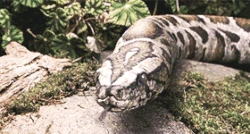
Harry unknowingly speaking parseltongue to a snake at the Zoo
Some wizards and witches had the ability to talk to animals. For instance, a Parselmouth could speak to snakes. This ability was extremely rare. Salazar Slytherin was an infamous Parselmouth,[23] and his descendants,[21] such as Lord Voldemort, inherited this trait. Harry Potter also acquired this ability when part of Voldemort's soul bonded with him the night he tried to kill Harry.[12]
Rubeus Hagrid has demonstrated an uncanny ability to communicate and bond with all kinds of animals,[10][23] though this may have not been a true magical trait, but merely a gift, a mere knack at interpreting animal behaviour, that some Muggles showed. Animagi had also demonstrated being able to subtly influence animals while assuming their animal forms.[11]
Maledictuses
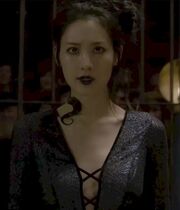
Nagini, prior to succumbing to her blood malediction
Some witches were the carriers of a blood curse, one that would eventually lead them turning into a beast permanently.[24] The curse was carried from birth and is passed down from parents to children. The beast form of a Maledictus individuals depended on the individual curse cast.[25]
Half-Veela

Fleur Delacour, a quarter-Veela
Veela had been known to marry wizards, and wizarding children of these unions were Half-Veela, and they would inherit magical ability from their wizarding parent, as well as the beauty, charm, and seductive dance from their Veela parent. Veela traits seemed to persist for at least a few generations (examples being Apolline Delacour, and her daughters Fleur, and Gabrielle). It is unknown whether half-blooded Veela could throw fire or transform into harpy-like creatures as their full-blooded relatives could.[26]
Late-bloomers
There exist some individuals that continue to exhibit a lack of magical power past age 11 and yet spontaneously — in desperate circumstances — manage to perform magic later on in life. However, this is rare, possibly more so than squibs.[27]
Acquired Traits
Animagi
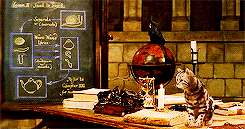
Minerva McGonagall, a registered Animagus with the form of a cat
While some wizards have the ability to turn into animals, it is not an inherent power, but rather a trained technique. This type of wizard is called an Animagus (plural Animagi). Babbitty Rabitty was said to be an Animagus with the ability to transform into a rabbit. Minerva McGonagall was an Animagus who could turn into a cat.[10][11] The first recorded Animagus was Falco Aesalon, who could turn into a falcon.[28]
The Animagi have to register themselves at the Ministry of Magic, because human Transfiguration can go horribly wrong. However, there are some unregistered Animagi. Examples are James Potter, who turned into a large red Stag; Sirius Black, who turned into a large black dog; Peter Pettigrew, who turned into a small grey rat;[11] and Rita Skeeter, who could turn into a beetle to gather information for her articles.[26] In the case of the first three, they turned into Animagi to assist Remus Lupin to transform into a werewolf in a place where there are no humans. Peter also turned into a rat to convince people that Sirius killed him, while masquerading as "Scabbers", Percy Weasley's and Ronald Weasley's former pet.[11]
Werewolves
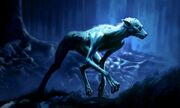
Remus Lupin, in his werewolf form
Some wizards are permanently infected with lycanthropy (also known as werewolfry)[29] when bitten by a werewolf, which forces the infected wizard to become a fearsome and deadly near-wolf upon the complete rising of the full moon. Werewolves appear in the form of a wolf but, there are distinctions between them and regular wolves.[11]
Legilimens
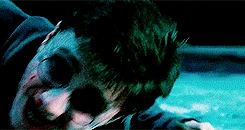
Lord Voldemort using Legilimency on Harry Potter
Legilimens are wizards who can perform Legilimency. These wizards can tune into other people's minds, but have difficulty reading the minds of those people who can perform Occlumency. The act of Legilimens is referred to as "mind-reading" in the Muggle world.[22] It is also possible to be born as a Legilimens, as Queenie Goldstein was noted to be a natural at the skill.[15]
Occlumens
Some wizards have the ability to protect their minds from others who can perform Legilimency. This ability is called Occlumency. Severus Snape tried teaching Occlumency to Harry Potter during Harry's fifth year in Hogwarts.[22]
Obscurials
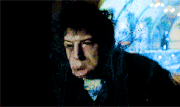
Credence transforming into his Obscurus form
An Obscurial is a witch or wizard who, due to being raised in an environment where their magic is viewed negatively, develops an Obscurus; a dark parasitic force resulting from their own magic being suppressed and tainted by negative emotion. Obscurials hardly ever live beyond the age of ten, the only verified case being that of Credence Barebone.[15]
Due to the extensive time spent suppressed, their magic, when unleashed as an Obscurus, can perform feats far more powerful than that of the average witch or wizard (indeed, the power of Credence's Obscurus impressed even Gellert Grindelwald), though usually only for short spans of time, as the user's death often follows soon after. At this point, the magic is in the control of the Obscurus itself, and cannot be directed by the Obscurial's will.[15]
Society
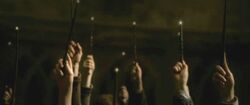
Wizards and witches raising their wands in a salute
As decreed by the International Statute of Wizarding Secrecy, wizards maintain a society entirely separate from Muggle society, with their own culture and traditions.[10] Wizards populate areas all over the globe. At the 1994 Quidditch World Cup, over 100,000 wizards were in attendance.[26] At Hogwarts School of Witchcraft and Wizardry, there are several hundred students in residence at any given time. About 30 million wizards attended Barry Winkle's 755th birthday party in 1991.[30]
It is not clear how many witches and wizards are in the entire world, but some hints are given. It is stated that there are ten times more Muggles than wizards in the world. If the global Muggle population was about 5 billion in the 1990s, it would mean that the wizard population was 500 million. However, it is also said that the British wizard population is about 3,000, one third being Hogwarts students. This would indicate a very low birth rate (although wizarding families are big, they live more than their Muggle counterparts) and mean that other countries are much more populous than Britain or that there is somewhere in the world where a very large concentration of wizards occur (one much larger than Britain's). In all likelihood, however, the former is a dramatic overestimate, the latter something of an underestimate.
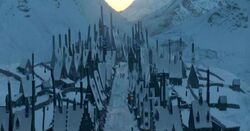
Hogsmeade village
Wizards may live together in communities such as Godric's Hollow[12] or Hogsmeade.[11] Other wizards live in solitary locations such as Spinner's End[21] or 12 Grimmauld Place.[22] The first wizarding communities are said to have come up in India[13] and the Middle East. More sophisticated communities would come up in Western Europe during the Middle Ages. Most wizards maintain little if no contact with Muggle society and find Muggles strange and unpleasant. They are somewhat ignorant to the Muggle world but in a different manner than Muggles as of the Wizarding World. While Muggles are completely unaware of wizards, wizards appear to be ignorant of certain aspects of the Muggle world, such as electricity and other modern technologies that become redundant and, at times, non-sensical when one is able to use magic. While certain aspects of Muggle society are evident in the wizarding one, wizards seem to be a number of decades if not centuries behind Muggles in other areas. In addition, wizards are sometimes just as progressive, if not more, on certain issues than their Muggle counterparts, such as women's rights.[13]
Some wizards do not like to talk about their Muggle relatives, or even deny their existence altogether. Other wizards, such as Lord Voldemort, have even killed some of their Muggle relatives altogether.[21] Other wizards, like Arthur Weasley find Muggles to be highly intriguing and ingenious.[23] Hermione Granger, a Muggle-born witch, took up Muggle Studies at Hogwarts because she felt it would be fascinating to think about Muggles from a wizarding perspective.[11]
Muggles who perform illusions or tricks to make it look as real magic is known as a magician. A true wizard being called magician is a grave insult to them, as Vernon Dursley did to James Potter I.[13]
See also
Behind the scenes
- Wizards are mentioned to be male members of wizardkind, while witches are mentioned to be female members, although wizard can be used to generalise. This is technically incorrect, as the male version of a witch is called a warlock and the female version of a wizard is called a Wizardess.
Appearances
- Harry Potter and the Philosopher's Stone (First appearance)
- Harry Potter and the Philosopher's Stone (film)
- Harry Potter and the Philosopher's Stone (video game)
- Harry Potter and the Chamber of Secrets
- Harry Potter and the Chamber of Secrets (film)
- Harry Potter and the Chamber of Secrets (video game)
- Harry Potter and the Prisoner of Azkaban
- Harry Potter and the Prisoner of Azkaban (film)
- Harry Potter and the Prisoner of Azkaban (video game)
- Harry Potter and the Goblet of Fire
- Harry Potter and the Goblet of Fire (film)
- Harry Potter and the Goblet of Fire (video game)
- Harry Potter and the Order of the Phoenix
- Harry Potter and the Order of the Phoenix (film)
- Harry Potter and the Order of the Phoenix (video game)
- Harry Potter and the Half-Blood Prince
- Harry Potter and the Half-Blood Prince (film)
- Harry Potter and the Half-Blood Prince (video game)
- Harry Potter and the Deathly Hallows
- Harry Potter and the Deathly Hallows: Part 1
- Harry Potter and the Deathly Hallows: Part 1 (video game)
- Harry Potter and the Deathly Hallows: Part 2
- Harry Potter and the Deathly Hallows: Part 2 (video game)
- Harry Potter and the Cursed Child
- Harry Potter and the Cursed Child (play)
- Quidditch Through the Ages
- Fantastic Beasts and Where to Find Them
- Fantastic Beasts and Where to Find Them: The Original Screenplay
- Fantastic Beasts and Where to Find Them (film)
- Fantastic Beasts: The Crimes of Grindelwald - The Original Screenplay
- Fantastic Beasts: The Crimes of Grindelwald
- Fantastic Beasts: The Secrets of Dumbledore
- Fantastic Beasts: Cases from the Wizarding World
- The Tales of Beedle the Bard
- Quidditch Through the Ages
- Harry Potter: A Pop-Up Book
- LEGO Creator: Harry Potter
- Creator: Harry Potter and the Chamber of Secrets
- LEGO Harry Potter: Building the Magical World
- LEGO Harry Potter
- LEGO Harry Potter: Years 1-4
- LEGO Harry Potter: Years 5-7
- LEGO Creator: Harry Potter
- Creator: Harry Potter and the Chamber of Secrets
- The Queen's Handbag
- Harry Potter: Quidditch World Cup
- Harry Potter for Kinect
- The Wizarding World of Harry Potter
- The Making of Harry Potter
- Harry Potter and the Deathly Hallows: Motorbike Escape
- LEGO Harry Potter
- Harry Potter Trading Card Game
- Pottermore
- Wizarding World
- Harry Potter Prequel
- Harry Potter Official Site
- Harry Potter: Spells
- Harry Potter for Kinect
- Wonderbook: Book of Spells
- Wonderbook: Book of Potions
- Harry Potter: The Character Vault
- Harry Potter: The Creature Vault
- Harry Potter: Hogwarts Mystery
- Harry Potter: Wizards Unite
- Harry Potter: Magic Awakened
- Harry Potter: Puzzles & Spells
- Hogwarts Legacy
Notes and references
- ↑ Harry Potter and the Chamber of Secrets, Chapter 7 (Mudbloods And Murmurs)
- ↑ Harry Potter and the Chamber of Secrets, Chapter 9 (The Writing on the Wall)
- ↑ Harry Potter and the Chamber of Secrets, Chapter 17 (The Heir of Slytherin)
- ↑ Harry Potter and the Chamber of Secrets (video game)
- ↑ Harry Potter and the Chamber of Secrets, Chapter 6 (Gilderoy Lockhart)
- ↑ Harry Potter and the Order of the Phoenix, Chapter 6 (The Noble and Most Ancient House of Black)
- ↑ Harry Potter and the Order of the Phoenix, Chapter 12 (Professor Umbridge)
- ↑ Harry Potter and the Order of the Phoenix, Chapter 27 (The Centaur and the Sneak)
- ↑ Harry Potter and the Philosopher's Stone, Chapter 16 (Through the Trapdoor)
- ↑ 10.0 10.1 10.2 10.3 10.4 10.5 Harry Potter and the Philosopher's Stone
- ↑ 11.0 11.1 11.2 11.3 11.4 11.5 11.6 11.7 11.8 Harry Potter and the Prisoner of Azkaban
- ↑ 12.0 12.1 12.2 Harry Potter and the Deathly Hallows
- ↑ 13.0 13.1 13.2 13.3 13.4 13.5 13.6 Pottermore
- ↑ Writing by J. K. Rowling: "Pure-Blood" at Wizarding World
- ↑ 15.0 15.1 15.2 15.3 Fantastic Beasts and Where to Find Them: The Original Screenplay
- ↑ Harry Potter and the Deathly Hallows, Chapter 15 (The Goblin's Revenge)
- ↑ 17.0 17.1 Writing by J. K. Rowling: "Illness and Disability" at Wizarding World
- ↑ The Making of Harry Potter - (see this image).
- ↑ Harry Potter and the Philosopher's Stone (film) - (see this image).
- ↑ J. K. Rowling interview with Scholastic
- ↑ 21.0 21.1 21.2 21.3 Harry Potter and the Half-Blood Prince
- ↑ 22.0 22.1 22.2 22.3 22.4 Harry Potter and the Order of the Phoenix
- ↑ 23.0 23.1 23.2 Harry Potter and the Chamber of Secrets
- ↑ Everything you need to know about Nagini at Pottermore
- ↑ @gabifcr: Is always a snake? @jk_rowling: No, they can be other creatures. Depends on the curse. by J.K. Rowling on Twitter
- ↑ 26.0 26.1 26.2 Harry Potter and the Goblet of Fire
- ↑ Accio Quote - J.K. Rowling's 1999 Barnes and Noble Interview
- ↑ Harry Potter and the Prisoner of Azkaban (video game)
- ↑ Harry Potter and the Prisoner of Azkaban (film)
- ↑ Harry Potter and the Philosopher's Stone (film)
